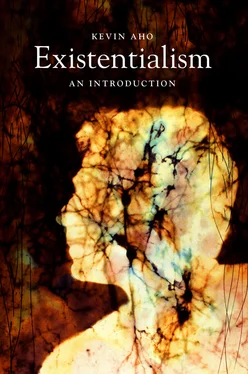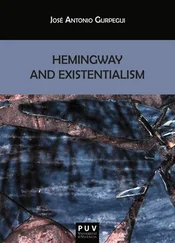Kevin Aho - Existentialism - An Introduction
Здесь есть возможность читать онлайн «Kevin Aho - Existentialism - An Introduction» весь текст электронной книги совершенно бесплатно (целиком полную версию без сокращений). В некоторых случаях можно слушать аудио, скачать через торрент в формате fb2 и присутствует краткое содержание. Год выпуска: 2013, ISBN: 2013, Издательство: Polity, Жанр: Философия, на английском языке. Описание произведения, (предисловие) а так же отзывы посетителей доступны на портале библиотеки ЛибКат.
- Название:Existentialism: An Introduction
- Автор:
- Издательство:Polity
- Жанр:
- Год:2013
- ISBN:978-0745651422
- Рейтинг книги:3 / 5. Голосов: 1
-
Избранное:Добавить в избранное
- Отзывы:
-
Ваша оценка:
- 60
- 1
- 2
- 3
- 4
- 5
Existentialism: An Introduction: краткое содержание, описание и аннотация
Предлагаем к чтению аннотацию, описание, краткое содержание или предисловие (зависит от того, что написал сам автор книги «Existentialism: An Introduction»). Если вы не нашли необходимую информацию о книге — напишите в комментариях, мы постараемся отыскать её.
Existentialism: An Introduction
Existentialism: An Introduction — читать онлайн бесплатно полную книгу (весь текст) целиком
Ниже представлен текст книги, разбитый по страницам. Система сохранения места последней прочитанной страницы, позволяет с удобством читать онлайн бесплатно книгу «Existentialism: An Introduction», без необходимости каждый раз заново искать на чём Вы остановились. Поставьте закладку, и сможете в любой момент перейти на страницу, на которой закончили чтение.
Интервал:
Закладка:
But the movement didn't reach its cultural zenith until it arrived in France in the 1930s. The five central figures, Jean-Paul Sartre (1905–1980), Simone de Beauvoir (1908–1986), Albert Camus (1913–1960), Gabriel Marcel (1889–1973), and Maurice Merleau-Ponty (1908–1961), all played key roles in turning postwar Paris, especially the Latin Quarter around the Sorbonne, into the intellectual and artistic epicenter of existentialism in Europe. By the time Sartre gave his seminal 1945 lecture ‘Existentialism Is a Humanism’ to a packed house in Paris, existentialism had firmly established itself as one of history's most significant philosophical movements. What accelerated the cultural reception of existentialism in France is the way it was presented, not in the formal and dry prose of German professors like Heidegger and Jaspers, but in accessible literary works, short stories, novels, and plays that appealed to a much broader audience. Although Sartre certainly contributed a dense and technical treatise with his Being and Nothingness (1945), he was best known and most recognized for his literary works and plays such as Nausea (1938), The Wall (1939), and No Exit (1944) that engaged themes of freedom, responsibility, and the contingency of existence. Indeed, he was awarded the Nobel Prize for Literature in 1964 but refused to accept it. Similarly, Camus, another Nobel laureate for literature in 1957, wrote influential novels and essays such as The Stranger (1942), The Myth of Sisyphus (1942), and The Rebel (1951) that reflected modern feelings of absurdity and alienation. And Beauvoir won the prestigious Prix Goncourt for her novel The Mandarins (1954) that explored the predicament of nihilism through the prism of postwar Europe and the Cold War.
What made these literary works so culturally relevant is that they did not deal with abstract philosophical problems but were ‘committed’ or ‘engaged’ ( engagée ) not only to the struggles of the human situation but also to the concrete social and political realities of the day. These figures played active roles in the Resistance of the Nazi occupation and all wrote extensively on politics and contemporary social problems. And Sartre, Beauvoir, and Merleau-Ponty together helped launch the influential journal of cultural criticism Les Temps Modernes in 1945 that became a crucial outlet for writers who resonated to the existentialist creed of a ‘ littérature engagée ’ such as American ex-patriot Richard Wright (1908–1960), Jean Genet (1910–1986), and Samuel Beckett (1906–1989). Beckett and Genet would go on to become principal players in ‘The Theatre of the Absurd’ in the 1960s, referring to plays that expressed the Camusian themes of meaninglessness and the loss of religious faith. Meanwhile, in the United States, ‘The Lost Generation’ of writers like F. Scott Fitzgerald (1896–1940) and Ernest Hemingway (1899–1961) were capturing the experience of anguish and moral anomie in America after the Great War. And later the ‘Beat’ or ‘Hip’ writers of the 1950s, like Jack Kerouac (1922–1969), Allen Ginsberg (1926–1997), and William S. Burroughs (1914–1997), began echoing cultural sentiments in France, prompting Normal Mailer (1923–2007) to declare, “Hip is an American existentialism” (cited in Barnes 1967, 155). These American writers illuminated the feeling of being tired or ‘beaten down’ by postwar conformism and authoritarianism and articulated the need for self-creation through bold experimentation with drugs, sex, travel, and music, a revolt that would set the stage for a much wider counter-culture revolution in the 1960s.
The French existentialists certainly set the tone for a broader literary movement in Europe and America. But the reach of the movement extended far beyond works of literature (see McBride 2012). In film, for instance, the French ‘New Wave’ was launched in 1960 with the release of Jean-Luc Godard's (b. 1930) film Breathless ( Á bout de souffle ). At the same time, Swedish filmmaker Ingmar Bergman (1918–2007) was making movies like The Seventh Seal (1957) and Through a Glass Darkly (1961), and Italian filmmaker Michelangelo Antonioni (1912–2007) was making Eclipse (1962) and The Red Desert (1964), all of which explored themes of human finitude, anxiety, and the death of God, themes that would be taken up later and popularized by the American director Woody Allen (b. 1934) in darker films like Interiors (1978), Another Woman (1988), and Crimes and Misdemeanors (1989). And in the world of art, the overlapping movements of cubism, surrealism, and abstract expressionism keyed into the cultural mood. At the turn of the century, Norwegian painter Edvard Munch's (1863–1944) The Scream captured the sense of existential dread; French Modernist Marcel Duchamp's (1887–1968) controversial painting Nude Descending Staircase, No. 2 (1912) revealed a newly fragmented, dehumanized, and mechanistic portrait of the human body; Spanish painter Pablo Picasso (1881–1973) provided witness to the horror and absurdity of technological warfare with Guernica (1937); the attenuated forms of Swiss sculptor Alberto Giacometti (1901–1966) reflected the modern experience of alienation and loneliness; and the American painter Jackson Pollock (1912–1956) cited the influence of existentialism on his convention-defying ‘drip style’ in his effort to express the importance of individual freedom and self-expression.
Outside of Europe and the United States, existentialism also had a significant impact in Latin America. Without question, it was the Spanish philosopher Ortega y Gasset who had the most influential role in introducing existentialist thought to the subcontinent, especially in Argentina, where he periodically taught and attended conferences in Buenos Aires between 1916 and 1940 (Garrido 2010, 145). One of Gasset's influences in Argentina, Carlos Astrada (1894–1970), published two important early works in existentialism, El juego existencial in 1933 and Idealismo fenomenológico y metafisica existencial in 1936. Gasset's Spanish compatriot José Gaos (1900–1969) brought existentialism to Mexico after becoming a citizen in 1941. In addition to the works of Kierkegaard, Gaos provided the definitive Spanish translation of Heidegger's Being and Time in 1951, more than ten years before the work was officially translated into English or French. And in 1939, Peruvian philosopher Wagner de Reyna (1915–2006), who was a student of Heidegger at Freiburg in the 1920s, published La ontología fundamental de Heidegger, one of the first comprehensive studies on the German philosopher (Oliveira 2010). These early pioneers, and many others, drew on the work of existentialists to engage concerns that were unique to the Latin American situation including critiques of totalitarianism, the problem of freedom and self-identity under colonialism, and the possibilities for revolution. And they set the stage for broad institutional developments across Latin America in the form of influential philosophical organizations and research groups devoted to existentialism and phenomenology.
Beyond philosophy, literature, and the arts, existentialism also left its mark on the thought of the most influential theologians of the time. Although already present in the nineteenth-century writings of figures like Kierkegaard and Dostoevsky, the religious or theistic expression of existentialism had a powerful incarnation in the twentieth century, especially in Protestant Germany, where Karl Barth (1886–1968), Paul Tillich (1886–1965), Rudolf Bultmann (1884–1976), and Dietrich Bonhoeffer (1906–1945) engaged existential questions regarding the relationship between faith and freedom, the meaning of anxiety in the modern age, and the terrifying incomprehensibility of God. The Jewish philosophers Martin Buber (1878–1965) and Emmanuel Levinas (1906–1995) also made important contributions. Buber envisioned the possibility of authentic dialogue between human beings by synthesizing aspects of the Hasidic mystical tradition with existentialism. He was well known for critiquing the alienating ‘I–It’ relations of modernity and offered what he called the ‘I — Thou’ relation as an alternative, one that is open and attentive to the intrinsic vulnerability of the other. And Levinas forwarded a notion of ‘ethics as first philosophy’ that begins from the concrete experience of exposure and openness to ‘the face’ of the other, an experience of vulnerability and suffering that undercuts our ordinary egoistic and objectifying tendencies. Catholic existentialists such as Marcel echoed this call for non-objectifying human relations through acts of charity and the experience of ‘communion’ with others. And from the Eastern Church, figures like Nikolai Berdyaev (1874–1948) used Christianity to attack the increasingly rational and mechanistic structure of modern society for the sake of human freedom and self-expression.
Читать дальшеИнтервал:
Закладка:
Похожие книги на «Existentialism: An Introduction»
Представляем Вашему вниманию похожие книги на «Existentialism: An Introduction» списком для выбора. Мы отобрали схожую по названию и смыслу литературу в надежде предоставить читателям больше вариантов отыскать новые, интересные, ещё непрочитанные произведения.
Обсуждение, отзывы о книге «Existentialism: An Introduction» и просто собственные мнения читателей. Оставьте ваши комментарии, напишите, что Вы думаете о произведении, его смысле или главных героях. Укажите что конкретно понравилось, а что нет, и почему Вы так считаете.












